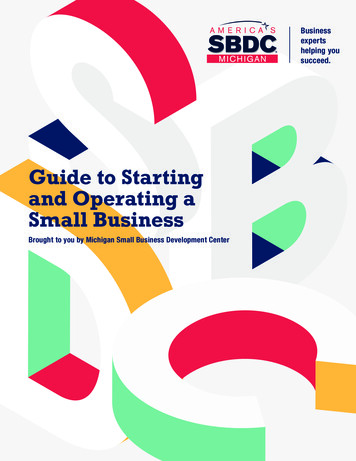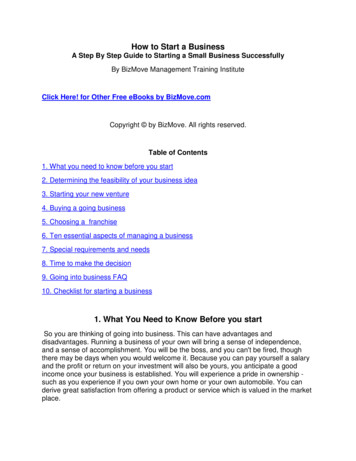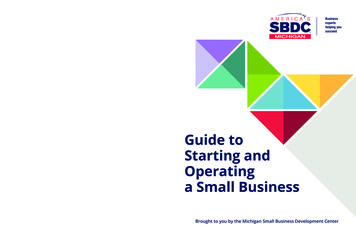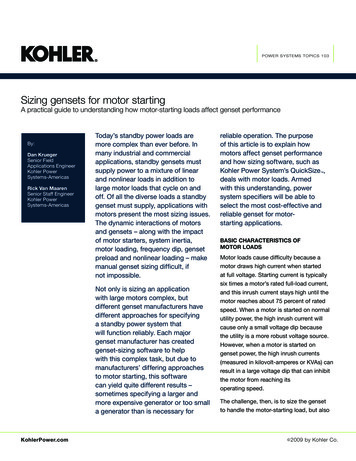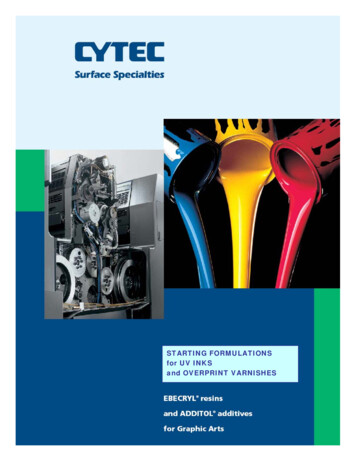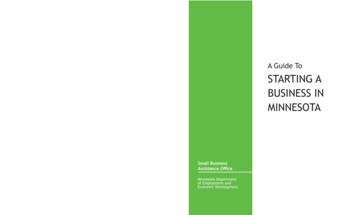
Transcription
A Guide To STARTING A BUSINESS IN MINNESOTAA Guide ToSTARTING ABUSINESS INMINNESOTASmall BusinessAssistance OfficeMinnesota Departmentof Employment andEconomic DevelopmentISBN 978-1-888404-85-2
A Guide To STARTING A BUSINESS IN MINNESOTA is updated annually.Copies are available without charge from the Minnesota Department of Employmentand Economic Development (DEED), Small Business Assistance Office,1st National Bank Building, 332 Minnesota Street, Suite E200, St. Paul, MN 55101-1351.Telephone: 651-556-8425 800-310-8323Email: deed.mnsbao@state.mn.us Website: Small Business Assistance OfficeUpon request, this publication can be made available in alternative formats bycontacting 651-259-7476.The Minnesota Department of Employment and Economic Development is an equal opportunityemployer and service provider.
A Guide ToSTARTING ABUSINESS INMINNESOTAThirty-ninth Edition, January 2021Charles A. SchafferMadeline HarrisMark SimmerCopyright 2021 Minnesota Department of Employment and Economic DevelopmentISBN 978-1-888404-85-2
PREFACEThis thirty-ninth edition of A Guide to Starting a Business in Minnesota, like its predecessors, isintended to provide a concise, summary discussion of the major issues faced by those starting abusiness in Minnesota. This edition of the Guide contains three major sections: the narrative text;a Resource Directory, which provides addresses, telephone numbers, and website addresses oforganizations referenced in the text; and the Directory of Licenses and Permits, which lists allbusiness licenses and permits required by the State of Minnesota, the state agency which issuesor administers the license or permit, and contact information. Topics presented in the narrativetext are presented in the order in which the new business owner typically must address them.Note that a business that will have operations or a physical presence (with the possible inclusionof an Internet presence) in another state should check with the government authorities in thatstate to obtain information on licensing, tax and other issues. We hope this organization is useful.While no one publication can answer every question for every kind of proposed business, thisGuide does respond to the questions and concerns most frequently raised. While it tries to beboth timely and comprehensive, this Guide is not intended as a final statement on any onesubject. In particular, users should be aware that the formal legal requirements for businessstart-up and operations may change from time to time. Specific updates and additionalinformation may be obtained from the many sources listed.Before engaging in any business venture, it is advisable to seek both legal counsel and advicefrom an accountant. Both professionals can advise you as to the best course you might take inestablishing your business. The information provided in this Guide is not intended to replacethat kind of advice and assistance.Charles A. SchafferMadeline HarrisMark Simmeri
TABLE OF CONTENTSPreface . iChoosing the Form of Business Organization .1Tax and Non-Tax Considerations . 1Naming the Business Entity.33Forming a Sole Proprietorship .39Forming a Partnership .40Forming a Minnesota Business Corporation .44Forming a Minnesota Limited Liability Company .51Special Types of Business Organizations . 56Filing Documents with the Office of the Minnesota Secretary of State .63Office of the Minnesota Secretary of State Fee Schedule for Business Entity Filings .65Regulatory Considerations .70Securities Registration .70Franchise Registration .77Evaluating a Business Opportunity .79Business Licenses and Permits .81Environmental Protection Programs .84Intellectual Property Protection .105Business Plan .106Accounting for the New Business .110Basic Accounting Principles .110Income Forecasting Techniques .112Business Grants .116Business Loans .117Public Sources of Financing – Federal Programs .119Public Sources of Financing / Tax Credits – State Programs . 127Public Sources of Financing – Local Programs .140Private Sources of Funds .140Insurance . 142Issues for Employers . .145Who is an Employee? .145Employment Agreements .151Labor Standards .152Rest Breaks and Leave Time .171Employee Testing and Background Checks .178Employment of Minors .181ii
Protection of Employees Who Report Violations of Law .185Human Rights.186Immigration Law Compliance .194Occupational Safety and Health .196Workers’ Compensation Insurance.202Employee Benefits .209Plant Closings.211Poster Requirements .212Checklist for Hiring an Employee.214Business Taxes.225Tax Identification Numbers .227Business Income Tax Returns .231Sales and Use Tax .237FICA Tax .243Income Tax Withholding .243Successor Liability for Certain Taxes When a Business or its Assets are Transferred .251Revocation or Prevention of License Issuance or Renewal .252Unemployment Insurance Taxes.252Federal Tax Requirements.260State of Minnesota Tax Requirements.261Sources of Information and Assistance.263State Programs.263Small Business Assistance Office.263Small Business Development Centers.264Minnesota Trade Office .265Minnesota Business First Stop.267Launch Minnesota.267Vocational Rehabilitation Service .267.Employment and Training Programs.268Minnesota Job Skills Partnership .269Dislocated Worker Program .270Minnesota Federal Bonding Service .270University of Minnesota Extension .271Government Procurement Assistance .271.Federal Procurement .271State Procurement .274Local Procurement.276Accounting and Tax Assistance .276Public Accountants .276Enrolled Agents .278Taxpayer Education Workshops .279Libraries .279Additional Sources of Assistance .283Specialized Legal Research and Assistance.283Management Assistance for Minority Businesses.284Incubators.284Inventors Resources.284Minnesota State .284iii
Regional Development Commissions .284Export / Import Assistance.285SCORE .285Women’s Business Center.286Resource Directory .291Cooperatives.293Environmental.293Export/Import Assistance.293Financing, Federal Sources.294Financing / Tax Credits, State Sources.296Financing, Local Sources.297Financing, Private Sources .300Government, Federal.301Government, State.305Government, Regional.315Insurance.316Inventors .316Job Service and Job Training.317Legal Assistance.319Libraries.320Local Assistance for Small Businesses.323Management Assistance, General .325Management Assistance for Minority Businesses.328Procurement / Purchasing / Certification / Other Assistance.329Tax and Accounting Assistance.331Additional Resources .331ADA Information .331County Licensing Agents .332City Licensing Agents .332Co-Working / Creative / Incubator Spaces .333Nonprofit Information .335Other .335Directory of Licenses and Permits.339iv
CHOOSING THE FORM OF BUSINESS ORGANIZATIONTAX AND NON-TAX CONSIDERATIONSINTRODUCTIONOne of the fundamental initial decisions a new business owner faces is choosing the form oforganization for the business. Generally speaking, a person should consider himself or herself tobe “in business” once they have begun the operation of an activity for which they expect to bepaid. This is true whether or not that person terminates other employment (such as a job thatbrings a paycheck), or intends to operate that business on a seasonal or short-term basis. Formost businesses, the choices are:Sole Proprietorship. In a sole proprietorship, the business is owned and controlled by oneindividual. This person alone receives the profits and bears the losses from the business, and thisperson alone is responsible for the debts and obligations of the business. Income and expensesof the business are reported on the proprietor’s individual income tax return, and profits aretaxed at the proprietor’s individual income tax rate. If a husband and wife wish to own a businesstogether, they must either form a partnership, corporation or limited liability company (in orderto have each of them be an owner of the business) or a sole proprietorship (in which case onlyone of them will be an owner of the business).Partnership. A general partnership is a business owned by two or more persons who associate tocarry on the business as a partnership. Partnerships have specific attributes, which are defined bystatute. All partners in a general partnership share equally in the right, and responsibility, tomanage the business, and each partner is responsible for all the debts and obligations of thebusiness. Distribution of profits and losses, allocation of management responsibilities, and otherissues affecting the partnership usually are defined in a written partnership agreement. Incomeand expenses of the partnership are reported on federal and state “information” tax returns,which are filed by the partnership. These include Schedules K-1 which are used to report to thepartner’s respective shares of partnership taxable income. The partners then report this incomeon their separate tax returns along with their other income and pay tax at their applicable incometax rates.A married couple who jointly operate an unincorporated business and who file a joint federalincome tax return can elect not to be treated as a partnership for federal tax purposes providedthat the husband and wife are the only members of the joint venture and materially participatein the running of the business. For more information refer to the Business Income Tax Returnssection of this Guide.1
A limited partnership is a type of partnership in which the limited partners share in thepartnership’s liability only up to the amount of their investment in the limited partnership. Bystatute, the limited partnership must have at least one general partner and one limited partner.The general partner has the right and responsibility to control the limited partnership, and isresponsible for the debts and obligations of the limited partnership. In Minnesota, a limitedpartner may participate in the management and control of the limited partnership without losinglimited liability protection but does not have the power to act for or bind the limited partnership(unless this is provided for in a separate agreement). Limited partnerships must be established incompliance with statutory requirements, including requirements of tax and securities laws.Because of their complex nature, limited partnerships should not be undertaken withoutcompetent professional advice.Limited Liability Partnership and Limited Liability Limited Partnership. A general partnershipmay register as a limited liability partnership (LLP) by filing a limited liability partnershipregistration. In limited liability partnerships, the personal assets of the partners are shieldedagainst liabilities incurred by the partnership in tort or contract situations. This is different froma non-LLP general partnership, in which partners may be personally liable to an unlimited extentfor the debts and obligations of the partnership. It should be noted that limited liabilitypartnerships are a relatively new type of entity and certain aspects, such as tax aspects, of suchentities are not yet fully developed or understood.Limited liability partnership status affords protection to the individual partner from liability forpartnership obligations in tort and contract. An LLP files with the Secretary of State an annualreport. There is a one-year grace period for retroactive reinstatement after revocation of LLPstatus for failure to file the annual report.Limited liability partnerships must have a name that includes one of the following: “RegisteredLimited Liability Partnership,” “Limited Liability Partnership,” “R.L.L.P.,” “L.L.P.,” “RLLP,” or “LLP.This should be used by the partnership in transactions with third parties so that they are aware ofthe partnership’s status.Minnesota law also allows a limited partnership to elect limited liability status under Minn. Stat.Chapter 321 by so designating this status in its certificate of limited partnership. This extendslimited liability protection to both general and limited partners. This type of limited partnershipis called a limited liability limited partnership. Limited liability limited partnerships are discussedbelow.Care should be taken in naming a limited liability limited partnership; the name must contain thephrase “limited liability limited partnership” or the abbreviation “LLLP” or “L.L.L.P.”, which mustbe part of the name, and must not otherwise contain the abbreviation “L.P.” or “LP.”Corporation. A corporation is a separate legal entity. It is owned by one or more shareholders.The corporation must be established in compliance with the statutory requirements of thestate of incorporation. The shareholders elect a board of directors which has responsibility formanagement and control of the corporation. Because the corporation is a separate legal entity,the corporation is responsible for the debts and obligations of the business. In most cases,shareholders are insulated from claims against the corporation.2
It is worth noting here that because a corporation is an entity separate from its owners, if theowner (and/or members of the owner’s family) performs services for the corporation, thesepersons are considered to be employees of the corporation. Thus, the corporation will berequired to comply with most of the laws and regulations and reporting requirements applicableto employers.The corporation may be taxed under Subchapter C of the Internal Revenue Code (a “Ccorporation”) or the provisions of Subchapter S of the Code (an “S corporation”). Minnesota taxlaws provide for comparable treatment.A C corporation reports its income and expenses on a corporation income tax return and is taxedon its profits at corporate income tax rates. The Minnesota corporate franchise tax, sometimescalled an income tax, is based on the portion of a C corporation’s income that is allocated toMinnesota. Profits are taxed without regard to payment of dividends, which generally are notdeductible. Dividends paid to shareholders are taxable income to them. This is sometimesreferred to as “double taxation” because this effectively taxes operating income twice, once tothe corporation and then again when distributed to the owners, although it actually is twoseparate taxpayers being taxed on their separate income.An S corporation election may be made by the shareholders of the corporation if the corporationmeets the statutory requirements for S corporation status. An S corporation that has not previouslybeen taxed as a C corporation is taxed in much the same manner as a partnership, i.e., the Scorporation files an information return to report its income and expenses, but it generally is notseparately taxed. Income and expenses of the S corporation “pass through” to the shareholdersin proportion to their shareholdings, and then are taxed to them at their individual rates. Underthe Internal Revenue Code, an S corporation may have only one class of stock (i.e., “common”stock, although voting differences are permitted), no more than 100 shareholders, and noshareholders that are nonresident aliens or non-individuals (e.g., corporations, partnerships,limited liability companies) except for certain estates, trusts, and certain tax exempt entities. Thefederal 2004 American Jobs Creation act allows an S corporation to treat shareholders within sixgenerations of one family as one shareholder thus allowing family business S corporations todistribute shares to family members of existing shareholders without those new shareholdersbeing counted as new shareholders against the 100 shareholder limit. S corporations are describedin more detail in later sections of this Guide. (If the shareholders of an existing C corporation electto have it taxed as an S corporation additional rules as well as corporate level taxes may come intoplay. Any such change in tax status should be discussed in advance with a competent tax advisor.)A closely held corporation is any corporation whose shares are held by a relatively small numberof shareholders. The Minnesota Business Corporation Act defines a closely held corporation asone which does not have more than 35 shareholders. Most closely held corporations are relativelysmall business enterprises, in which all shareholders tend to be active in the management of thebusiness. Some states provide a separate, less formal, less restrictive set of laws for closely-heldcorporations. Minnesota does not. In Minnesota, the business corporation law is geared to smallcorporations, so a separate law is not necessary, and all corporations operate under one law.Limited Liability Company. A Minnesota business also may organize as a limited liability company.A limited liability company may have one or more members. As described further in the sectionon tax considerations in choosing the form of organization, under Treasury Regulations regardingentity classification the members of limited liability companies have some flexibility with respectto the federal income tax treatment of their entities. Under these rules a limited liability company3
with more than one member will be taxed as a partnership unless it elects to be taxed as acorporation and a limited liability company with only one member will be taxed as a soleproprietorship (a “disregarded entity”) unless it elects to be taxed as a corporation. The applicableRegulations appear in 26 C.F.R. § 301.7701-1, et. seq.A limited liability company that is taxed as a partnership or as a corporation must obtain its owntax ID numbers. A limited liability company with only one member that is taxed as a soleproprietorship generally does not need to obtain separate federal or state tax identificationnumbers unless it has employees or pays federal excise taxes, in which case it will obtain tax IDnumbers and use them to remit employment taxes or pay excise taxes.Business income and losses of a limited liability company that is taxed as a partnership or as a soleproprietorship are passed through to the members, included in their taxable income, and taxedat each member’s income tax rate. As with a corporation, liability for business debts and obligationsgenerally rests with the entity rather than with the individual owners. A limited liability companyis not subject to many of the restrictions that apply to S corporations (unless it elects to be taxedas a corporation and wishes to be taxed as an S corporation). All members of a limited liabilitycompany may participate in the active management of the company without risking loss of limitedpersonal liability. Minnesota adopted a new Limited Liability Company Act (Minn. Stat. Chapter322C) that became effective August 1, 2015. Minnesota limited liability companies formed on orafter that date are subject to the new act, and may be managed by the members, by a board ofgovernors, or by a manager.Other Forms of Organization. Other forms of organization available to Minnesota businessesinclude professional organizations, cooperative associations, business trusts, and certain variationsof these forms of organization. These types of organizations are established and regulated bystatute and involve complex legal, financial and accounting issues. Organizing under any of theseforms should not be
subject. In particular, users should be aware that the formal legal requirements for business start-up and operations may change from time to time. Specific updates and additional information may be obtained from the many sources listed. Before engaging in any business venture, it is ad
